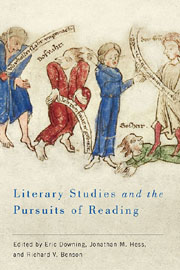Book contents
- Frontmatter
- Contents
- List of Illustrations
- Introduction
- Part I Medieval and Early Modern Practices of Reading
- 1 Apertio Libri: Codex and Conversion
- 2 The Question of Reading and the Medieval Book: Reception and Manuscript Variation of Thomasin's Welscher Gast
- 3 Reading in Nuremberg's Fifteenth-Century Carnival Plays
- 4 Shakespeare, Biblical Interpretation, and the Elusiveness of Meaning
- Part II Reading, Secularization, and Transcendence in the Long Nineteenth Century
- Part III Theories and Practices of Reading in the Twentieth Century and Beyond
- Part IV Postscript: The Ends of Reading
- Works Cited
- Notes on the Contributors
- Index
4 - Shakespeare, Biblical Interpretation, and the Elusiveness of Meaning
from Part I - Medieval and Early Modern Practices of Reading
Published online by Cambridge University Press: 05 February 2013
- Frontmatter
- Contents
- List of Illustrations
- Introduction
- Part I Medieval and Early Modern Practices of Reading
- 1 Apertio Libri: Codex and Conversion
- 2 The Question of Reading and the Medieval Book: Reception and Manuscript Variation of Thomasin's Welscher Gast
- 3 Reading in Nuremberg's Fifteenth-Century Carnival Plays
- 4 Shakespeare, Biblical Interpretation, and the Elusiveness of Meaning
- Part II Reading, Secularization, and Transcendence in the Long Nineteenth Century
- Part III Theories and Practices of Reading in the Twentieth Century and Beyond
- Part IV Postscript: The Ends of Reading
- Works Cited
- Notes on the Contributors
- Index
Summary
Shakespeare's depiction of readers and reading persistently demonstrates that texts—whether written, spoken, gestural, or visual—fail reliably to deliver their authors' intended meanings. This essay begins by offering a few illustrations of this striking feature of Shakespeare's plays and then explores the possibility that the playwright may have developed his remarkable self-consciousness about methods of interpretation by reading and hearing it practiced—and observing methodical interpretation yield conflicting results. Conspicuous demonstrations of interpreters at work, and in conflict, were in Shakespeare's time most readily on display in his contemporaries' efforts to understand the Bible, the all-sufficient guide to salvation and virtuous living in Protestant Europe.
In Shakespeare's plays, the instability of textual meaning becomes most obvious when one of the play's characters becomes the text in question, interpreted before our eyes. Among the most striking of these occasions occurs in Much Ado About Nothing (ca. 1598–1599). Possessed by Don John's manipulation, Claudio insists, in the climactic episode of the play, on interpreting his intended bride's blushes as evidence that the villain's fabricated narrative of her sexual misbehavior is true. Her father, Leonato, struck by the apparent sincerity of Claudio's accusations and Don Pedro's authority, quickly accepts their accusations of harlotry as “the story that is printed in her blood.” The friar who was to marry the young lovers in this scene, governed by his reading, his experience, and his scripturally grounded resistance to rash negative judgment, reads that same “printing” as signs of modesty, innocence, and justifiable anger.
- Type
- Chapter
- Information
- Literary Studies and the Pursuits of Reading , pp. 84 - 102Publisher: Boydell & BrewerPrint publication year: 2012

